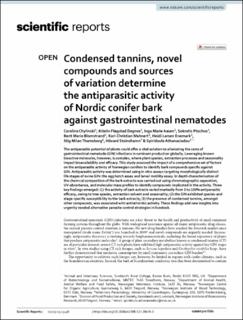| dc.contributor.author | Chylinski, Caroline | |
| dc.contributor.author | Degnes, Kristin Fløgstad | |
| dc.contributor.author | Aasen, Inga Marie | |
| dc.contributor.author | Ptochos, Sokratis | |
| dc.contributor.author | Blomstrand, Berit Marie | |
| dc.contributor.author | Mahnert, Karl-Christian | |
| dc.contributor.author | Enemark, Heidi L | |
| dc.contributor.author | Thamsborg, Stig Milan | |
| dc.contributor.author | Steinshamn, Håvard | |
| dc.contributor.author | Athanasiadou, Spiridoula | |
| dc.date.accessioned | 2024-04-22T09:20:09Z | |
| dc.date.available | 2024-04-22T09:20:09Z | |
| dc.date.created | 2023-09-05T11:02:40Z | |
| dc.date.issued | 2023 | |
| dc.identifier.citation | Scientific Reports. 2023, 13: 13498. | en_US |
| dc.identifier.issn | 2045-2322 | |
| dc.identifier.uri | https://hdl.handle.net/11250/3127553 | |
| dc.description.abstract | The antiparasitic potential of plants could offer a vital solution to alleviating the costs of gastrointestinal nematode (GIN) infections in ruminant production globally. Leveraging known bioactive molecules, however, is complex, where plant species, extraction processes and seasonality impact bioavailability and efficacy. This study assessed the impact of a comprehensive set of factors on the antiparasitic activity of Norwegian conifers to identify bark compounds specific against GIN. Antiparasitic activity was determined using in vitro assays targeting morphologically distinct life stages of ovine GIN: the egg hatch assay and larval motility assay. In depth characterisation of the chemical composition of the bark extracts was carried out using chromatographic separation, UV-absorbance, and molecular mass profiles to identify compounds implicated in the activity. Three key findings emerged: (1) the activity of bark extracts varied markedly from 0 to 100% antiparasitic efficacy, owing to tree species, extraction solvent and seasonality; (2) the GIN exhibited species-and stage-specific susceptibility to the bark extracts; (3) the presence of condensed tannins, amongst other compounds, was associated with anthelmintic activity. These findings add new insights into urgently needed alternative parasite control strategies in livestock. | en_US |
| dc.language.iso | eng | en_US |
| dc.publisher | Springer Nature | en_US |
| dc.relation.uri | https://www.nature.com/articles/s41598-023-38476-0#Abs1 | |
| dc.rights | Navngivelse 4.0 Internasjonal | * |
| dc.rights.uri | http://creativecommons.org/licenses/by/4.0/deed.no | * |
| dc.title | Condensed tannins, novel compounds and sources of variation determine the antiparasitic activity of Nordic conifer bark against gastrointestinal nematodes | en_US |
| dc.title.alternative | Condensed tannins, novel compounds and sources of variation determine the antiparasitic activity of Nordic conifer bark against gastrointestinal nematodes | en_US |
| dc.type | Peer reviewed | en_US |
| dc.type | Journal article | en_US |
| dc.description.version | publishedVersion | en_US |
| dc.rights.holder | © The Author(s) 2023. Published by Springer Nature. | en_US |
| dc.source.pagenumber | 12 | en_US |
| dc.source.volume | 13 | en_US |
| dc.source.journal | Scientific Reports | en_US |
| dc.identifier.doi | 10.1038/s41598-023-38476-0 | |
| dc.identifier.cristin | 2172434 | |
| dc.relation.project | Norges forskningsråd: 268264 | en_US |
| dc.source.articlenumber | 13498 | en_US |
| cristin.ispublished | true | |
| cristin.fulltext | original | |
| cristin.qualitycode | 1 | |

